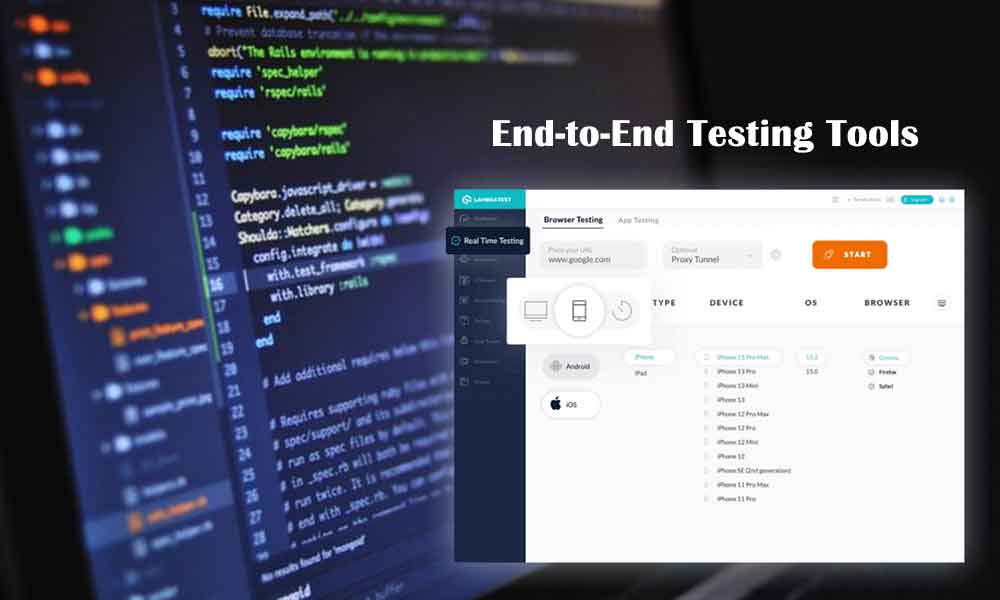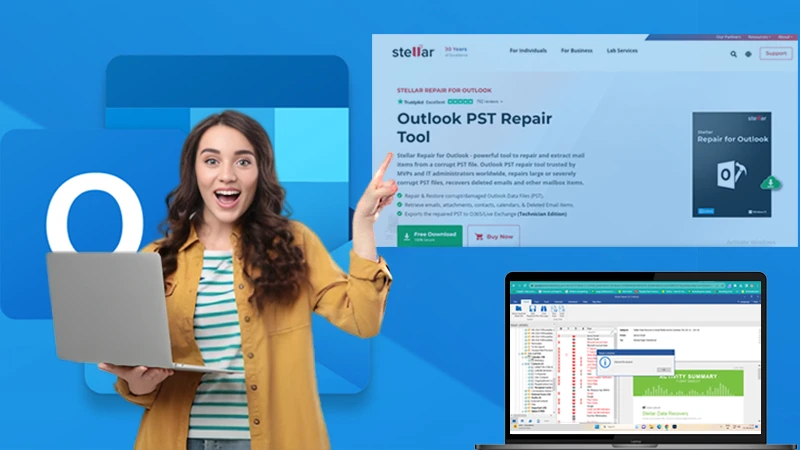Top 11 End-to-End Testing Tools

An end-to-end testing tool is a software tool that performs automated tests for applications and websites. It is used to test the functionality of an application or website from the user’s perspective and can be used to automate manual testing.
End-to-end testing tools allow you to perform automated tests that validate the entire workflow of your application or website in one single run. They also allow you to work with a wide range of browsers, operating systems, and devices.
What is End-to-End Testing?
End-to-end testing is a way to make sure that your application works from start to finish, instead of just testing the individual pieces. It’s one of the most important parts of software testing and can help you catch bugs before they get out into the world.
The first step in end-to-end testing is creating a test plan. This will include things like what you’re going to test, how you’ll test it, and what kinds of results you expect to see. Then, you’ll write a script that can automate these steps so that every time someone runs the script again, they’ll get the same results. You may have heard this called “automated testing.”
After your script is written, it’s time for QA (quality assurance) to run through all of its steps. If anything goes wrong in this process—if an error message pops up or there’s unexpected behavior—that’s a bug that needs fixing.
End-to-end testing is a broad term that refers to all types of software testing done from the user’s perspective, after all, other testing has been completed. This type of testing ensures that the product works as expected for end users, and it can be performed by an automated tool or by a human.
End-to-End Testing Definitions
In this article, we’re going to cover end-to-end testing definitions and examples.
End-to-end testing is a type of software testing where the tests run on the complete system rather than its components. It’s also known as integration testing or functional testing because it checks how well the different parts of a system work together to achieve the desired result.
The purpose of end-to-end testing is to make sure that all components of an application are working properly with one another. This includes any external systems that may be integrated with it, such as databases or third-party APIs (Application Programming Interfaces). End-to-end tests simulate real user scenarios and can be used for validating both functionality and performance.
End-to-end testing is a type of software testing that provides assurance that an application or system behaves as expected from start to finish, across multiple browsers and devices. It is often considered one of the most complex types of software testing because it simulates real user interaction.
More specifically, end-to-end testing involves a series of automated tests that are run from beginning to end and ensures that a system behaves as expected for each test case.
Types of End-to-End Tests
There are two main types of end-to-end tests: black box and white box tests. White box tests are designed to test each function within an application individually, while black box tests focus on overall features instead of specific functions.
black box testing can be used to test the whole application from start to finish.
It may also include system testing, which tests the complete system (including hardware and software) as opposed to individual components. It can also be used to test complex workflows or user journeys.
End-to-end testing is often used in conjunction with other types of testing, including unit testing, integration testing, and functional testing. It can be performed manually or automatically by running automated scripts against a live system.
End-to-end testing is a way to test the entire flow of an application. It tests the system as a whole, and it checks the interactions between different components. The main purpose of end-to-end testing is to ensure that every feature works as expected.
Functional and Non-functional End-to-end Tests
Functional end-to-end testing focuses on ensuring that an application performs its intended functions in a reliable and repeatable manner. It tests all aspects of an application’s functionality, including input validation, output generation, error handling, etc.
Non-functional end-to-end testing focuses on whether an application meets non-functional requirements such as response time, performance optimization, etc.
The types of end-to-end testing also include:
- Functional Testing: It checks if the application works correctly. Tests the functional aspects of an application. It checks whether all the features of an application are working as they should.
- Regression Testing: It checks whether any changes in the code have broken any existing features or functionality. Checks whether a new feature has broken any existing functionality in an application. This type of testing is performed after every release to ensure that no new bugs have been introduced in the latest release.
- Performance Testing: It measures how fast the application performs under various load conditions and configurations so that you can identify bottlenecks and fix them before they become a problem for users or business stakeholders. Automated tests can be used to test web applications and mobile applications without any human intervention. They can be programmed in such a way that they run on their own without any external input from humans or machines.
- User Interface (UI) Testing: This type of testing verifies that the user interface of your application behaves as expected. It checks the entire application flow and ensures that all elements on each page function properly.
- Service Level Agreement (SLA): This type of testing verifies that your application meets its SLA by ensuring it can handle peak loads without slowing down or crashing.
Advantages of End-to-end Testing
- End-to-end testing is a testing approach that tests the system as a whole, including all its components and touchpoints. This means that end-to-end testing is done from the user’s perspective, and it makes sure they can accomplish their goals as expected.
- End-to-end tests are typically conducted by automation engineers or testers who specialize in this type of testing. The tester will be responsible for setting up the test environment, executing the test script, and analyzing the results.
- In order to ensure that end-to-end tests are thorough, it’s important that they include all necessary steps from start to finish. For example, if you’re testing an application with a signup process, that would include signing up for an account itself but also ensuring that users can receive verification emails when they register successfully.
- The advantage of end-to-end tests is that they provide high coverage because they test all of your application’s features from start to finish. They also make sure that problems don’t occur at any point during this process and identify issues before they become critical problems later on down the line.
- A lot of people don’t realize the advantages of end-to-end testing. While unit testing can be a great way to find bugs in your code, end-to-end testing is a much more comprehensive way to make sure that your entire system is working the way it should.
- End-to-end testing, or E2E for short, is a process that involves testing the entire system from start to finish. This means all components are tested as they interact with each other. This is helpful because it’s easy for bugs in one part of the system to affect other parts without you realizing it. When you’re running E2E tests on your site, you’re ensuring that everything works together as planned.
- E2E tests also help ensure that updates don’t break anything else in your app or website when they’re released—they’re basically like a safety net for developers who want to make changes but aren’t sure how those changes will affect their software overall. You’ll know right away if something goes wrong with an update so you can fix it quickly before anyone else notices!
Disadvantages of End-to-end Testing
End-to-end testing is a widely used method of testing software. While it can be a powerful tool, there are also some shortfalls of end-to-end testing that make it less than ideal for some applications.
It does not test the logic of your code
End-to-end testing only tests the user interface—the part that users interact with. This means that the inner workings of your code will never be analyzed or tested by this kind of testing.
It can cause problems with other parts of your application
Sometimes, an end-to-end test will require dependencies on other systems or services outside of your control, which could cause issues in production if you were to deploy the code without fixing these problems first.
It doesn’t give you information about what’s happening inside your system
The only thing that end-to-end tests tell you is whether or not something works as expected on its own. They don’t give any information about why something isn’t working correctly or how to fix it, which can be very frustrating when trying to troubleshoot problems with this type of testing strategy!
When it comes to testing, one size does not fit all. While unit testing and integration testing are important parts of your testing strategy, they do not cover everything. If you want to find out if your application is secure, reliable, and functioning as expected, end-to-end testing is the way to go.
End-to-end testing is a type of black box test that runs through the entire system from start to finish. It can be used to test any number of features in an application—from user authentication to data validation—and is especially helpful when it comes to ensuring that all parts of an application work together as expected.
But there are some disadvantages that come with end-to-end testing as well:
End-to-end tests can be time-consuming because they require more resources than other types of tests; they may take longer than some automated tests because they require manual intervention at different points throughout their execution; they may be difficult to maintain because they often involve several different systems that need to communicate with each other; and finally, these tests might not always provide enough information about what went wrong when something goes wrong during execution (which means more work for testers).
End-to-end testing has some significant shortcomings that could make or break your project.
The first is that it takes time—a lot of time. If you have a short deadline and a lot of features to test, then this might not be for you. Because end-to-end tests involve simulating every user interaction with each feature, they can take days or weeks depending on how big your application is. In some cases, they might even take months!
The second problem with end-to-end testing is that it requires a lot of resources and infrastructure. You need a browser or device emulator running full-stack environments that include all the various dependencies your application needs (e.g., databases). You also need someone who knows how to automate these tests so they can run on their own without human intervention (which means learning to program).
How can LambdaTest help?
LamdaTest is an automation testing tool helping you perform end-to-end, multi-device, and cross-browser tests efficiently. LamdaTest is a cloud-based functional testing solution that helps you perform end-to-end tests for your apps and websites. Our platform is designed to easily run tests across various browsers and OS, generate reports in multiple formats, integrate with CI tools, and track the performance of tests over time.










